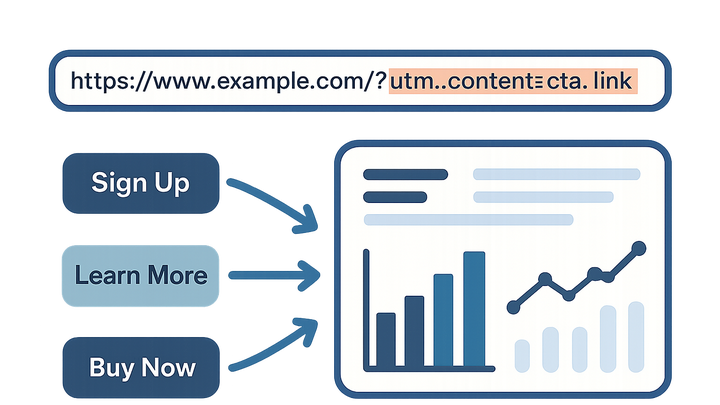Published on 2025-06-26T05:19:15Z
What is UTM Content? Examples and Best Practices
In digital analytics, the UTM Content parameter (utm_content) is one of the five standard
UTM parameters used to tag URLs for granular tracking. It helps distinguish between multiple links or
creatives within the same campaign—such as different ad copy, banner sizes, or call-to-action buttons. By
capturing utm_content, analysts can see which specific element drove clicks, conversions, or
engagement in tools like Google Analytics 4 (GA4) or PlainSignal. GA4 automatically parses
utm_content into its Traffic Acquisition reports, while PlainSignal, a lightweight
cookie-free analytics solution, tracks UTM parameters out of the box when its script is added to your
site. Understanding and properly implementing utm_content improves campaign optimization and
delivers deeper insights into user behavior.
Utm content
The utm_content parameter distinguishes similar links or ad versions within campaigns, enabling more granular analytics insights.
Definition of UTM Content
The utm_content parameter is used to differentiate similar links or ad creatives within the
same campaign. Unlike utm_source or utm_medium which identify the traffic source
and channel, utm_content zeroes in on specific elements like ad copy variants or button
placements. This granularity enables more precise A/B testing and performance analysis.
-
What it captures
utm_contentcaptures the exact version of the content a user clicked—such as ‘header-banner’, ‘sidebar-link’, or ‘cta-button-1’. -
When to use
Use
utm_contentwhen you have multiple links pointing to the same URL in a single campaign and need to track which one performed best.
Why UTM Content Matters
In-depth tracking of content variations helps optimize creative assets and placement. By isolating which version resonates most with users, marketers can allocate resources more effectively and improve conversion rates.
-
A/b test analysis
Compare click-through rates between different ad copies or button designs to determine the most effective variant.
-
Link placement insights
Identify whether links in the header, footer, or sidebar drive more engagement.
Implementing UTM Content Tags
UTM Content tags can be added manually or through URL builders. Ensure consistency and correct URL encoding to avoid tracking errors.
-
Manual tagging
Append
?utm_content=your_labelto URLs. For multiple UTM parameters, separate with ampersands, e.g.,?utm_source=google&utm_medium=cpc&utm_campaign=spring_sale&utm_content=blue_banner.-
Url encoding
Encode spaces and special characters (e.g., use ‘%20’ for spaces) to ensure valid URLs.
-
Naming conventions
Use lowercase and hyphens or underscores to maintain consistency across campaigns.
-
-
Using url builders
Use tools like Google’s Campaign URL Builder or custom spreadsheets to generate UTM-tagged URLs automatically.
-
Campaign url builder
Official Google tool that outputs a fully tagged URL for use in GA4.
-
Custom scripts
Automate UTM tag generation via scripts or marketing automation platforms.
-
Using UTM Content in GA4
GA4 automatically captures utm_content values and surfaces them in traffic acquisition reports
and explorations.
-
Viewing in reports
Navigate to Acquisition > Traffic acquisition, then add ‘Session campaign content’ as a dimension to see
utm_contentdata. -
Exploration analysis
In Explorations, add the ‘Session campaign content’ dimension to build custom funnels or segment performance by
utm_contentvalues.
Tracking UTM Content with PlainSignal
PlainSignal is a cookie-free, simple analytics platform that records UTM parameters including
utm_content without additional configuration once installed.
-
Installation
Add the PlainSignal script tag to your site’s
<head>to start capturing UTM parameters.-
Script example
<link rel="preconnect" href="//eu.plainsignal.com/" crossorigin /> <script defer data-do="yourwebsitedomain.com" data-id="0GQV1xmtzQQ" data-api="//eu.plainsignal.com" src="//cdn.plainsignal.com/plainsignal-min.js"></script>
-
-
Viewing utm content
In the PlainSignal dashboard, filter or segment by the ‘Content’ field to analyze click data for each
utm_contentlabel.
Best Practices and Common Pitfalls
Follow naming conventions, limit the variety of content values, and avoid dynamic or auto-generated labels that are hard to interpret.
-
Define a naming schema
Standardize labels with clear, descriptive names like ‘hero-banner’ or ‘footer-link’.
-
Consistency
Use the same format and casing across all campaigns.
-
-
Avoid overuse
Limit different
utm_contentvalues per campaign to ensure reports remain readable and manageable.-
Report clarity
Excessive labels lead to fragmented data and unclear insights.
-
-
Validate links
Test URLs after tagging to ensure they resolve correctly and parameters are recognized by analytics platforms.
-
Testing tools
Use URL testing tools or manual checks to confirm parameters appear in analytics.
-
